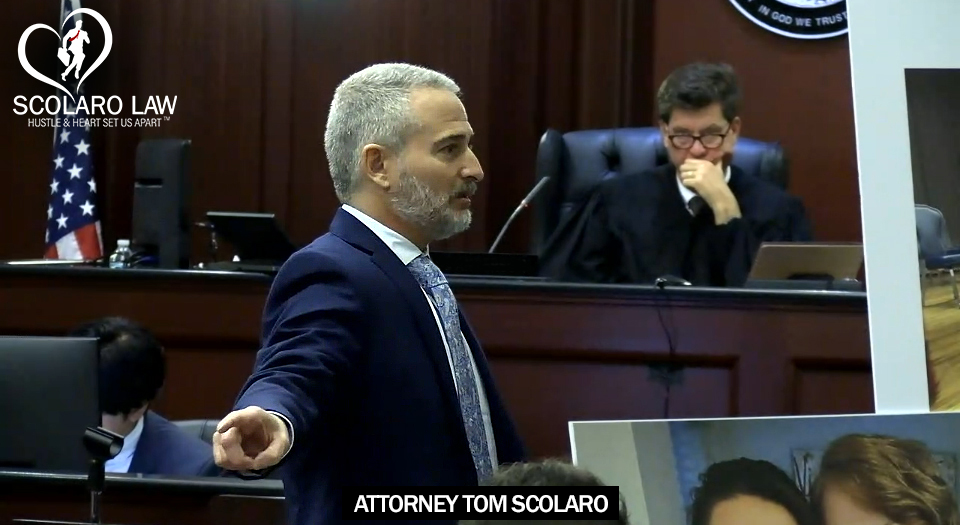
Get Started with a Free Consultation
If you were injured in an incident in Florida, contact us by filling out this form.
"*" indicates required fields
Trucking accident case in Central Florida results in $3 Million settlement
May 30, 2024
Thomas Scolaro recently achieved a $3 million settlement for our Central Florida client and his family. This client suffered a mild brain injury when a truck driver ran a red light. The truck T-boned a vehicle with the right of way before losing control and crashing into our client’s stationary car. Initially, our client’s family considered hiring one of Florida’s larger firms, but they were discouraged by their impersonal approach. After meeting with Thomas Scolaro, the family was reassured that their husband and father had a caring, experienced trucking attorney to represent him and their family in this case.
Tom assured them that they would receive dedicated personal attention and a commitment to excellence, which meant diligently pursuing their case and striving for the best possible outcome. Piece by piece during litigation, Mr. Scolaro built the case with irrefutable evidence that the truck driver’s reckless actions were the direct cause of the catastrophic accident that injured this bystanding client.
Two Depositions and a black box
During his deposition, the truck driver testified that he was driving at a constant speed, under the speed limit, and crossed the intersection with a green light and the right of way. He claimed that the light never turned yellow or red and insisted that he maintained a steady pace as he entered the intersection. This testimony was crucial as it aimed to absolve him of any wrongdoing and shift the blame away from his reckless driving.
However, the truth came to light when we analyzed the data of his truck’s black box. The download revealed a starkly different story: the truck was traveling at constant speed for a long distance, but once he approached the traffic light, the data showed the driver steadily accelerated and went over the speed limit. This critical piece of evidence demonstrated that the driver attempted to “beat the light” by speeding up as soon as the light turned yellow. The data unequivocally contradicted his deposition testimony and exposed the defendant’s lies.
The conclusion drawn from this revelation was clear. The truck driver had acted negligently and dishonestly. His attempt to rush through the intersection not only violated traffic laws but also led to a catastrophic accident. As our client waited in the left turn lane, completely stopped at the red light, the truck driver approached the intersection from the opposite direction, westbound in the middle lane. Despite his claims of maintaining a constant speed and having the green light, the evidence showed that he had accelerated before entering the intersection, a reckless behavior that resulted in the truck crossing the intersection above the speed limit with the red light.
Simultaneously, another driver, who had been waiting at the red light to turn left and head eastbound, began his turn as soon as his light turned green. Unaware of the speeding truck barreling towards the intersection, this driver proceeded with his left turn. At that critical moment, the truck driver, now driving well above the speed limit, entered the intersection against the red light and collided with the turning vehicle. The impact was catastrophic. The force of the collision caused the truck to roll onto its side and to slide across the intersection and crash head-on into our client’s vehicle.
Tom Scolaro preserved the testimony of the third-party driver who was T-boned by the 18-wheeler. Despite the defense’s best attempts to attack his character, this witness testified under oath that he was stopped at the red light for at least two minutes before the light turned green. He also testified to waiting an additional two to three seconds before pushing the accelerator.
The pivotal evidence not only discredited the truck driver’s deposition testimony but also underscored the preventable nature of the accident, buttressing the liability of our client’s claim. Ultimately the case settled before trial for $3,000,000.
Trucking Accident Cases and the Role of Black Box Technology
In the world of commercial transportation, safety and compliance are paramount concerns. With the rise of advanced technology, the integration of black box systems in 18-wheelers and other large commercial vehicles has become increasingly common. These black box systems, also known as event data recorders (EDRs), play a crucial role in improving road safety, enhancing fleet management, and facilitating accident investigations.
Event Data Recorders (EDRs)
Similar to the black boxes found in airplanes, event data recorders installed in 18-wheelers capture and store critical information about the vehicle’s technical operations and driving conditions. EDRs are equipped to record data such as vehicle speed, brake application, steering angle, seatbelt usage, airbag deployment, and pre- and post-collision data.
In the event of an accident, EDR data provides invaluable insights into the circumstances leading up to the collision, helping accident investigators reconstruct the sequence of events and determine the root causes of the incident. This data is instrumental in determining whether the truck driver was negligent and ultimately liable for the incident.
Ten Tips On How To Approach Trucking Cases
Prompt Investigation: Start investigating immediately. Preserve evidence by sending spoliation letters to the trucking company to ensure that crucial evidence like driver logs, maintenance records, and the truck’s black box data is not destroyed.
Gather Comprehensive Evidence: Collect all available evidence, including police reports, witness statements, surveillance footage, and photographs of the accident scene. Ensure you obtain the truck’s Electronic Control Module (ECM) or black box data to analyze speed, braking, and other critical factors.
Examine Driver Records: Investigate the truck driver’s history. Look for prior accidents, driving violations, and compliance with Federal Motor Carrier Safety Administration (FMCSA) regulations. Obtain the driver’s logbooks to check for violations of hours-of-service rules.
Analyze Truck Maintenance Records: Review the trucking company’s maintenance records to identify any failures in maintaining the vehicle properly. Faulty brakes, worn tires, or other mechanical issues can be crucial evidence.
Investigate the Trucking Company’s Practices: Investigate the trucking company’s hiring, training, and supervision practices. Look for patterns of negligence, such as hiring unqualified drivers or failing to enforce safety protocols.
Retain Experts early: Work with accident reconstruction experts, medical professionals, and trucking industry experts to build a strong case. Experts can provide insights into how the accident happened and the extent of injuries and damages. Retain them early so as to avoid conflicts.
Go to the scene: Rule 101, do not rely on photos or google earth. Instead, visit the accident scene in person. Understanding the layout, traffic patterns, and environmental conditions can provide valuable context and help in not only reconstructing the accident, but also .
Scrutinize Insurance Coverage: Conduct a thorough review of all relevant insurance policies of the trucking company. Who are the insureds, what is insured, what are the limits and endorsements. If your claim is against a large trucking company, you may have to parse through insurance policies pertaining to the entire fleet. Be thorough and pay attention to detail.
Understand Federal and State Regulations: Be well-versed in both federal regulations (such as FMCSA rules) and state laws governing trucking operations. Knowledge of these regulations can be determinant to identify violations that contributed to the accident.
Request the driver’s electronic logging devices (ELD): ELDs serve as a modern replacement for traditional paper logbooks used by truck drivers to record their hours of service. Mandated by regulatory agencies such as the Federal Motor Carrier Safety Administration in the United States, ELDs are designed to accurately track and record various aspects of a driver’s activities, including driving time, engine hours, vehicle movement, miles driven, and location information. In litigation, the primary purpose of requesting and analyzing ELDs is to determine whether driver fatigue, a leading cause of accidents in the transportation industry, played a role in a collision.
Prepare for Settlement or Trial: Be ready to negotiate a settlement, but also prepare for trial. In today’s environment, you must develop a detailed litigation strategy more than ever.
Truck Accident Cases Require Experienced Personal Injury Attorney and Experimented Legal Team
Thomas Scolaro has built a respected reputation among his peers over the past four decades. At Scolaro Law, we handle catastrophic injury and wrongful death cases across Miami, the Florida Keys, and the entire state of Florida. We collaborate with leading experts and draw on our collective century of experience to achieve the best results for our clients.
What to Do if You Are Injured in a Truck Accident: A Guide for Protecting Your Rights
Truck accidents are traumatic and overwhelming, often resulting in serious injuries and complex legal issues. If you find yourself injured in a truck accident, it is crucial to take specific steps to ensure your safety, protect your rights, and strengthen your personal injury claim.
First and foremost, it is essential to stay calm. Keeping a clear head will help you handle the situation effectively and make rational decisions. If possible, move your vehicle to a safe spot away from traffic to prevent further collisions or injuries. Safety should always be your top priority.
Avoid any confrontation with the other driver involved in the accident. Engaging in altercations can escalate the situation and complicate the legal process. Instead, focus on civil interactions and ensure you exchange essential information with the other driver. This includes insurance details, driver’s license numbers, and vehicle registrations. Accurate information exchange is crucial for any subsequent legal actions.
Gathering witness information can be extremely beneficial for your claim. Collect names, addresses, and phone numbers from any willing witnesses. Their testimony can provide valuable support if there are disputes about the accident.
Seeking immediate medical attention is vital, even if you believe your injuries are minor. The full extent of trauma from an accident might not be apparent immediately, and some injuries can manifest days later. A prompt medical evaluation ensures that any injuries are documented, which can be crucial for your personal injury claim.
Documenting the scene is another important step. Take clear photographs of the accident site, including vehicle damage, road conditions, and any visible injuries. This visual evidence can be instrumental in establishing the facts of the accident.
It’s also important to limit your statements about the accident. Do not provide a statement to the other driver’s insurance company, as you are not obligated to discuss the accident with them. Making statements without legal guidance can jeopardize your claim. Instead, consult with a personal injury lawyer before giving any statement to your own insurance company.
Following these steps can help safeguard your health and legal rights after a truck accident. For expert guidance and to maximize your claim, contact a specialized personal injury lawyer experienced in truck accidents. A knowledgeable attorney can navigate the complexities of your case, ensuring you receive the compensation you deserve. By taking these actions, you can effectively protect yourself and your interests in the aftermath of a truck accident.
If you were involved in a trucking accident or collision, contact us by filling out this online form and our team will get back to you shortly to evaluate your claim and determine the best ways to assist you with your legal claim(s).

